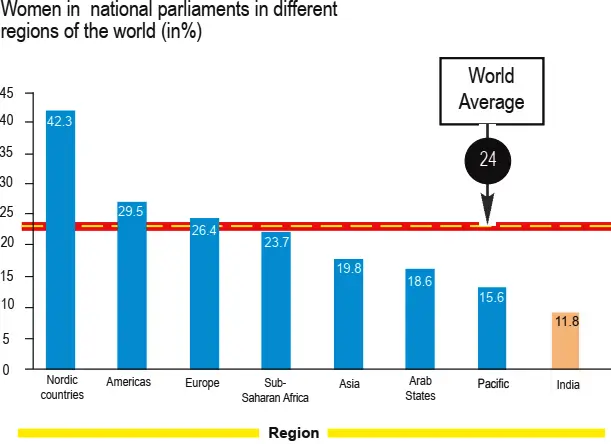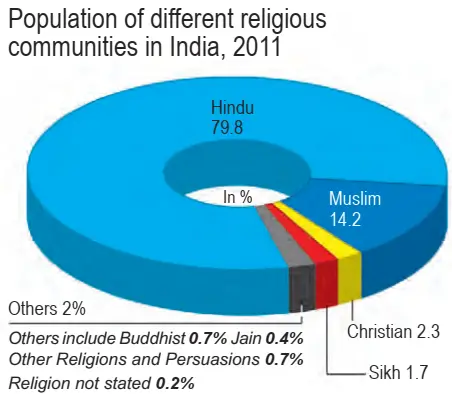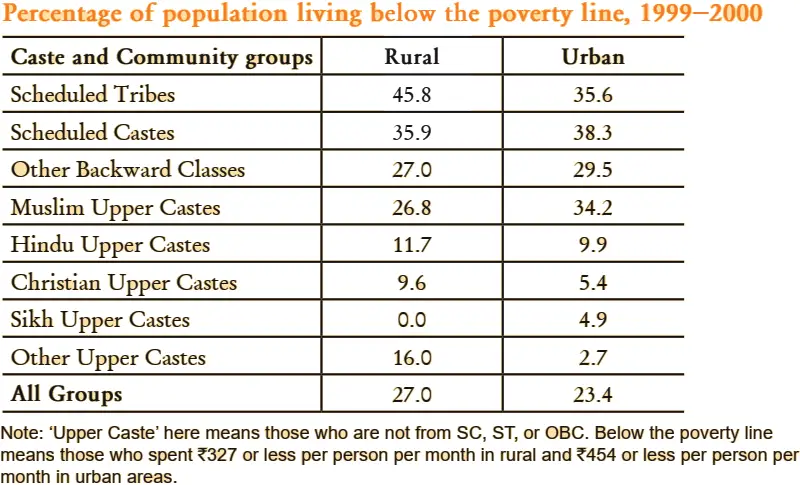Revision Notes for Class 10 Political Science – Chapter 3 Gender, Religion and Caste
Are you confused on Revision Notes? Revision Notes for class 10 Political Science – 3 Gender, Religion and Caste is the right place to refer.
The existence of social diversity does not threaten democracy. Political expression of social differences is possible and sometimes quite desirable in a democratic system. Social differences can take the form of social divisions and inequalities.
Gender and Politics
- Gender division is a form of hierarchical social division seen everywhere but is rarely recognised in the study of politics.
- The gender division tends to be understood as natural and unchangeable.
- It is not based on biology but on social expectations and stereotypes.
Public/Private Division
- Sexual Division of labour: Boys and girls are brought up to believe that the main responsibility of women is housework and bringing up children.
- Low value for Women’s work:
- Women’s work is not valued to equal to the work of men.
- Double jeopardy: Majority of women do some sort of paid work in addition to domestic labour.
- Result of Division of labour:
- Although women constitute half of the humanity, their role in public life, especially politics, is minimal in most societies.
- Earlier, only men were allowed to participate in public affairs, vote and contest for public offices.
- Feminist movements: Women in different parts of the world organised and agitated for equal rights. These agitations demanded enhancing the political and legal status of women and improving their educational and career opportunities.
Improvement in Women’s role in Public life
- Women are now found in working as scientists, doctors, engineers, etc. which were earlier not considered suitable for women.
- In some parts of the world, for example in Scandinavian countries such as Sweden, Norway and Finland, the participation of women in public life is very high.
Condition of Women in India
Disadvantage, Discrimination and Oppression faced by Women:
- In education:
- The literacy rate among women is only 54 per cent as compared to 76 per cent among men.
- High dropout rates: Parents prefer to spend their resources for their boys’ education.
- In jobs:
- The proportion of women is low in highly paid and valued jobs.
- Their work is not valued even though, on an average an Indian woman works one hour more than an average man every day.
- Unequal wages:
- They do not get equal wages for doing same work as that of men.
- The Equal Remuneration Act, 1976 provides that equal wages should be paid to equal work but in almost all areas of work women are paid less than men.
- Crime against Women:
- There are reports of various kinds of harassment, exploitation, and violence against women.
- Domestic violence: They are not safe even within their own home from beating and harassment.
- Preference for boys:
- Sex-selective abortion: In many parts of India, parents prefer to have sons and find ways to have the girl child aborted before she is born. This led to a decline in child sex ratio to merely 919.
Women’s Political Representation
Issues related to women’s well-being or otherwise are not given adequate attention. Unless women control power, their problems will not get adequate attention.
Women as Elected Representatives
- Less participation of women in Legislature of India:
- The percentage of elected women members in Lok Sabha has touched 14.36 per cent of its total strength for the first time in 2019.
- Their share in the State assemblies is less than 5 per cent.
- India is among the bottom group of nations in the world. India is behind the averages for several developing countries of Africa and Latin America.
- In the Government, Cabinets are largely all-male even when a woman becomes the Chief Minister or the Prime Minister.
Measures to improve Women participation in Legislatures
- To make it legally binding to have a fair proportion of women in the elected bodies. For instance, in Local Bodies, one-third of seats in local government bodies are now reserved for women.
- There has been demand for similar of at least one-third of seats in the Lok Sabha and State Assemblies for women. A bill with this proposal has been pending before the Parliament for more than a decade.
Social and Religious Diversity of India
The Census of India records the religion of every Indian after every ten years. Since Independence, the total population of each community has increased substantially but their proportion in the country’s population has not changed much.
- The proportion of Muslim, Sikh and Buddhist population has increased slightly.
Composition of Religious communities
- The population of the Hindus, Jains and Christians has declined marginally since 1961.
- Common but mistaken impression about the Muslims: It is believed that the proportion of the Muslims in the country’s population is going to overtake other religious communities.
- However, in actual, the balance in composition of different religions is expected to not change in big way.
- Expert estimates done for Sachar Committee show that the proportion of the Muslims is expected to go up a little, by about 3 to 4 per cent, in the next 50 years.
Common but mistaken impression about the Muslims: It is believed that the proportion of the Muslims in the country’s population is going to overtake other religious communities.
- Major Caste groups:
- In 2011, the Scheduled Castes were 16.6 per cent and the Scheduled Tribes were 8.6 per cent of the country’s population.
- The Census does not yet count the Other Backward Classes. The National Sample Survey of 2004-05 estimates their population to be around 41 per cent.
- The SC, ST and the OBC together account for about two-thirds of the country’s population and about three-fourths of the Hindu population.
Religion, Communalism and Politics
Religious differences-based divisions are not as Universal as the Gender, but religious diversity is widespread in the world today. Even when most of the people belong to the same religion, there can be serious differences about the way people practice that religion. Unlike Gender differences, the Religious differences are often expressed in the field of politics.
Relationship between Religion and Politics
- Gandhiji used to say that Religion can never be separated from Politics where the religion was not any particular religion but moral values that inform all religions. He believed that Politics must be guided by ethics drawn from Religion.
- Human Rights groups in India have argued that most of the victims of communal riots in our country are people from Religious minorities.
- Women’s movement has argued that family laws of all religions discriminate against women.
- It is notable that the political acts are not wrong if they treat every religion equally. Ideas, ideals and values drawn from different religions can and perhaps should play a role in politics.
Communalism and Religion
Communalism becomes a problem when religion is seen as the basis of the nation.
- Communal Politics: When beliefs of one religion are presented as superior to those of other religions and the State power is used to establish domination of one religious-group over others.
- Idea behind Communal Politics: The Religion is the principal basis of social community.
- The followers of a particular religion belong to one community and their fundamental interests are the same.
- Also, People who follow different religions cannot belong to the same social community. Their interests are bound to be different and involve a conflict.
- Extreme form of Communalism: It leads to the belief that people belonging to different religions cannot live as equal citizens within one nation. Either one of them has to dominate the rest or they have to form different nations.
Flaws in the Idea of Communalism
People of one religion do not have the same interests and aspirations in every context. Everyone has several other roles, positions, and identities. Any attempt to bring all followers of one religion together in context of other than religion is bound to suppress many voices within that community.
Various forms of Communalism in Politics
- In everyday beliefs, it involves religious prejudices, stereotypes of religious communities and belief in the superiority of one’s religion over other religions.
- Quest for Political domination of one’s own religious community:
- For those belonging to majority community, this takes the form of majoritarian dominance.
- For those belonging to the minority community, it can take the form of a desire to form a separate political unit.
- Political Mobilisation on Religious lines: It involves the use of sacred symbols, religious leaders, emotional appeal and plain fear in order to bring the followers of one religion together in the political arena.
- Communal violence, riots and massacre: India and Pakistan suffered some of the worst communal riots at the time of the Partition.
Secular State
A Secular State is one which is officially neutral in matters of religion, supporting neither religion nor irreligion.
Reflection of Secular State in our Constitutional provisions in India: Unlike Sri Lanka where Buddhism is the official religion of the country, India has no official religion. This could be expanded as:
- It provides to all individuals and communities freedom to profess, practice, and propagate any religion.
- It prohibits discrimination on grounds of the Religion.
- It allows the State to intervene in the matters of religion in order to ensure equality within religious communities.
Secularism is not just an ideology of some parties or persons but constitutes one of the foundations of our country. Communalism threatens the very idea of India.
Prevailing Caste inequality
National Sample Survey shows that the Caste continues to be very strongly linked to economic status in many important ways:
- The average economic status (measured by criteria like monthly consumption expenditure) of caste groups still follows the old hierarchy. For example, the ‘upper’ castes are best off and the Dalits and Adivasis are worst off.
- Although every caste has some poor members, the proportion living in extreme poverty (below the official ‘poverty line’) is much higher for the lowest castes and much lower for the upper castes.
- The upper castes are heavily over-represented among the rich while the lower castes are severely under-represented.
Caste and politics
Basis of Caste System: Caste System is rooted in the belief that caste is the sole basis of social community and people belonging to the same caste belong to a natural social community and have the same interests which they do not share with anyone from another caste.
Caste Inequalities: Unlike Gender and Religion, Caste division is special to India.
- All societies have some kind of social inequality and some form of Division of labour.
- In most societies, occupations are passed on from one generation to another. Its extreme form is Caste system.
- In Caste system, Hereditary occupational division was sanctioned by rituals.
- Members of the same caste group were supposed to form a social community that practiced the same or similar occupation, married within the caste group etc.
- Caste system was based on exclusion of and discrimination against the ‘outcaste’ groups. They were subjected to the inhuman practice of untouchability.
Changes in Caste System in Modern India
- There is breakdown of caste hierarchy due to economic development, large scale urbanization, growth of education, occupational mobility and the weakening of the position of landlords in the villages.
- The Constitution of India prohibited any caste-based discrimination and laid the foundations of policies to reverse the injustices of the caste system.
Non- disappearance of castes in the contemporary India
- Some of the older aspects of caste have persisted like even now most people marry within their own caste or tribe.
- Untouchability has not ended completely, despite the Constitutional prohibition.
- The Caste groups that had access to education under the old system have done very well in acquiring modern education.
- Caste continues to be closely linked to economic status.
Caste in Politics
Manifestation of Caste in Politics:
- Selection of candidates in Elections: Parties keep in mind the caste composition of the electorate and nominate candidates from different castes to muster necessary support to win elections.
- Raising caste sentiments: Political parties and Candidates in elections make appeals based on caste sentiment to muster support.
- Political mobilization: Universal Adult Franchise and the Principle of ‘one-person-one-vote’ have compelled political leaders to gear up to the task of mobilising and securing political support of particular communities.
Elections and Caste
- Parties need support of more than one caste: No parliamentary constituency in the country has a clear majority of one single caste.
- No party wins the votes of all the voters of a caste or community.
- Some voters have more than one candidate from their caste while many voters have no candidate from their caste.
- The ruling party and the sitting MP or MLA frequently lose elections in our country. This signify that all castes and communities were not frozen in their political preferences.
Flaws in the Idea of Caste Politics
- People within the same caste or community have different interests depending on their economic condition. Rich and poor or men and women from the same caste often vote very differently.
- People’s assessment of the performance of the government and the popularity rating of the leaders matters and are often decisive in elections.
Politics in Caste
Politics also influences the caste system and caste identities by bringing them into the political arena. Thus, it is not politics that gets caste-ridden, it is the caste that gets politicised.
Manifestation of Politics in Caste
- Each caste group tries to become bigger by incorporating the neighbouring castes or sub-castes which were earlier excluded from it.
- Various caste groups are required to enter into a coalition with other castes or communities and thus enter into a dialogue and negotiation.
- New kinds of caste groups have come up in the political arena like ‘backward’ and ‘forward’ caste groups.
- In some situations, expression of caste differences in politics gives many disadvantaged communities the space to demand their share of power.
Interesting points
- Child Sex Ratio is the number of girl children per thousand boys.
- A ‘Time use survey’ conducted by the Government of India in six Indian states shows that an average woman works every day for a little over seven and half hours while an average man works for six and a half hours.







